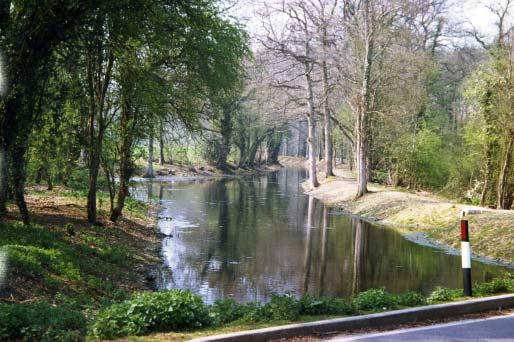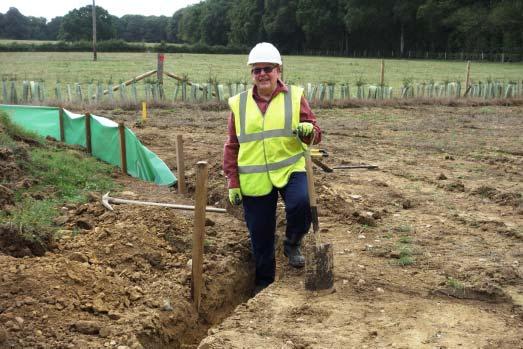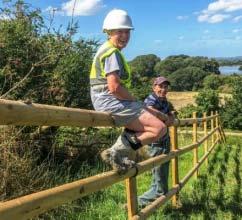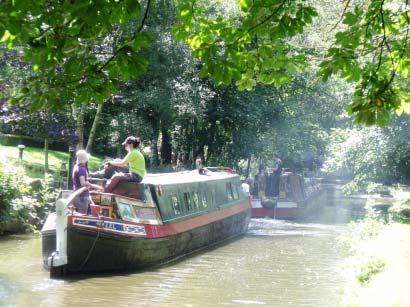
13 minute read
Progress news roundup
progress Wey & Arun
Our round-up of progress on waterway restoration projects begins on the Wey & Arun, with early stages of the next big project at Tickner’s Heath
Wey & Arun Canal
You all know that volunteers don’t need asking twice when there’s an exciting and large-scale project to get our teeth into, and it so it was when the green light was finally given to begin work on the Wey & Arun Canal Trust’s latest major restoration project near the canal’s summit.
A combination of the NWPG mobile group’s volunteers and the Trust’s own volunteers have been working together on the third Saturday of the month for some time at various sites along the canal, but with such a big project to tackle we’ve now extended this to every Thursday as well.
The project involves building a road bridge, pedestrian bridge and eventually digging out 200m of new canal at Tickner’s Heath, near Dunsfold, where the route of the canal is blocked by the causeway which carries Dunsfold Road.
The site won’t be new to Navvies readers: last October WRG Forestry worked their magic on some trees that needed to be cut back here as part of a week-long camp. WRG BITM have held a weekend on the site in very muddy conditions installing drainage and stripping topsoil. A team from Southern Water also sent its staff along to plant a new 120m long hedge comprising some 720 mixed native shrubs along the boundary fencing (back before lockdown when these things could be done). In January some 120 8x4ft fence panels were painted a fetching forest green by NWPG and other northern team volunteers which will form the hoarding fence for the site works compound
The details: the new road bridge will be built within the footprint of the existing
Pictures by WACT
highway so a short length of temporary road will be constructed to divert traffic around the bridge site during the duration of the construction works. With the bridge in place and the road reopened to traffic, a new canal cut some 200yards long will be excavated below the bridge and will then curve around to rejoin the original canal to the west of the old crossing. Genius.
The first task for us on the ground was surfacing for an access track and laying car parking on the agricultural field where the construction compound will be housed. In early September, WACT northern team volunteers assisted by the trust’s Mid Week Working Party have been carrying out ecology management and tree felling works in preparation. There’s lots of prep needed before the heavy work can begin in earnest in spring 2021, contractors will be brought in for specialist operations where needed, but there’s no shortage of work before then for both the trusts volunteers and WRG.
Of the jobs completed so far by the team, the highlights have been two culverts that needed to be installed – volunteers using the excavator cut the channels while another sub-team filled 120 sand bags with concrete and laid the pipework. All’s well until the pipework is too long for the hole dug… cue the disc cutter!
The other – and strangest job - was for a barrier to be erected around the huge mound of topsoil taken when the site was first cleared. The soil’s earmarked for reuse on site as topsoil for the landscaping in three years’ time and so won’t be there for ever. For newts, however, it’s apparently a very ‘des res’ and if there were any of the little fellas lurking around they would happily set up home there.
Because the newts are sensitive souls (or something like that) we could only use pickaxes and spades to dig out the trench around the mound and set up the green plastic newt fencing. We weren’t all so thankful for the long hot summer then, as the ground was dry as a bone and hard as nails to dig. Thankfully the temperature had dropped from the highs of the previous weeks.
With autumn round the corner, the matting bought for last year’s Birtley Bridge work then came out and was relaid, for when the heavy clay turns from rock hard to claggy.
This Tickner’s Road Crossing isn’t going to be a quick job, however – two to three years is the current estimate, giving us navvies plenty to keep us occupied.

progress Wendover Arm
Meanwhile on the Wendover Arm they’ve been getting back to work after lockdown and getting their Whitehouses and Bridge 4 projects on track
Grand Union Wendover Arm
Wendover Arm Trust’s July working party was the first for several months due to Covid-19 lockdown and restrictions.
July working party: A return to site started on 16 July with plant machines being delivered. Volunteers arrived the next day. The Covid-19 arrangements arising from our risk assessment had worked well enough to go beyond the trial period. However, there were some more tasks that needed to be taken on to improve our arrangements for the August work party.
The first part of the week was spent moving materials down to the work sites using the newly modified trailer towed behind a dumper truck.
After clearing a stack of old reclaimed bricks and pumping water out, it was found that machines could run along the bed back to the area known as Whitehouses. This was important for us because we needed to be able travel back on the section that has been finished to complete the brick work on the walls and the former manhole in the canal bed (see below). This could not be achieved earlier in the year due to the bed being saturated from the heavy rain at the start of the year. The focus of transport was changed to getting the required materials to Whitehouses and starting work on clearing the vegetation. Over several days concrete blocks and bricks were transported to both Bridge 4 and Whitehouses work areas.
After a consultation with our farmer next door the fence materials for the Whitehouse tip area were moved from where stored on his farm to our site, and work on the fencing progressed through the work party. The fence would be finished next month to allow sheep netting to be added and handed over to the sheep!
To keep the work groups separated several tasks were performed simultaneously. We had one person building the hollow block wall at bridge 4, a team on the fencing and others moving the materials.
Although the vegetation growth during our absence had been dramatic it did not affect the work tasks.
We had a good response for volunteer numbers, and they were particularly good at following the C-19 avoidance rules.
August working party: Once again, building on the experience from July, the work

Whitehouses former pumping station site showing wing wall foundations and blockwork. The mixer is on the pipe capping extension. Alongside are the beams covering the manhole page 30
party was organised to meet the requirements of our own Covid-19 risk assessment outcomes. One of the ways this was achieved was that the work areas were well spaced out to avoid crowding.
The work party ran over two weeks, which contained the most variable summer weather we have seen for a long time. It started dry and warmish, became extremely hot and sunny then the thunderstorms and heavy showers began. Even with the amount of rain we had, the excavators and dumpers were still able to reach Whitehouses.

On the second Wednesday the weather was so bad the work party was suspended for a day. Many days started with water being pumped out at Bridge 4. The work party was a success and there were some big strides forward.
The detail of the various jobs and tasks has been condensed because a lot happened over the two weeks and there is only space for the headlines! Over two weeks there were a large amount of detailed jobs and materials delivery. With access to Whitehouses now possi-
Pictures by Wendover Arm Trust
New Brickwork around Bridge 4 stop plank grooves
ble, materials were moved local to the work site.
New walls at Bridge 4: The block work was completed and each of the hollow block “holes” had a reinforcing rod inserted then filled with concrete. A layer of waterproofing was added to the block surfaces. The brick work on the offside was started (this incorporates the stop plank channels) and is now around two-thirds built.
At Whitehouses (site of a former pumping station - see pic opposite) the existing pipe capping (a protective covering being laid over the top of the pipe laid in the canal bed to continue its function as a water feeder to the Grand Union Main Line when the canal was allowed to run dry) was extended with reinforced ready-mix concrete to reach the manhole (which is also in the canal bed, and needs to be dismantled / capped to allow the canal to be reinstated above it). Each end of the capping has a step down to accommodate the concrete beams that go across the manhole. The area for the new wing wall foundations was excavated, levelled, had form work made up and the concreting was completed by using ready mixed concrete. (in pouring rain!) Following on from that, form work was built up to enable the “front apron” support concreting to be completed. Following on from the wing wall foundations being laid, the block work was started and completed over the course of the work party.
The manhole was uncovered, and the top layers of the chamber bricks removed to the required height. Concrete floor beams and solid concrete blocks were used to cover the manhole. More concrete was applied on both sides to limit the beams’ sideways movement. It will be possible to lift the beams for access to the manhole until the Bentomat (waterproof bentonite matting used to line the channel) is laid over the whole area. Longer term it will be possible to identify the manhole position and get access for any maintenance that may be required.
Whitehouses Fencing
The fence at Whitehouses land reclamation was completed. We had a short handover ceremony to Keith Slade, the tenant farmer who will now use the land for sheep grazing. We have now informed Herts CC that the land is no longer being used by WAT and is now being used by their tenant farmer.
Car park hut:
A small flat pack hut was delivered, a base was laid, and the hut assembled in a position next to the car park entrance. This now contains the equipment and materials to deal with C19. It is also
used to store some pieces of equipment. All signing in and H and S information is within this hut so that volunteers can be briefed daily on the current situation as they come on to the work site.
Brick cleaning:
Over the course of the work party a backup (but important) job was to clean up the old bricks that came from the old swingbridge walls. A large stack has now been cleaned ready for when we start on the wall restoration.
Environmental Group: Having recognised that a large part of restoration concerns Environmental issues, a new subgroup has been initiated. They will look after and advise us on all things environmental, ranging from butterflies to beetles, Ash trees to reeds and make sure we improve the environment local to the canal whenever we can.
Full Contractor Appraisal: We were recently informed by CRT that our application had been signed off. We are now an Approved Contractor to CRT!
Conclusion: It was amazing just how much we got done despite the weather and C19. We now have two more very capable Team Leaders and both of those together with

Vice-chair Leanda tries out the new fence
the volunteers should be congratulated for working in the weather conditions we had.
We also had 3 new volunteers and a CRT Apprentice join us this month, we must be doing something right?
Tony Bardwell Operations Director, Wendover Arm Trust tony.bardwell@wendoverarmtrust.co.uk
Wendover Arm
Length: 6 miles Locks: 0 (1 stop-lock added) Date closed: 1904
Grand Union Main Line to Birmingham
The Wendover Arm
has the dubious distinction of having been built as a navigable feeder to provide a water supply to the Grand Junction (now the Grand Union) Canal, but ending up leaking so much that it was actually costing the canal water. Attempts to waterproof it (including lining a section of it Infilled section: solution needed for contaminated infill problem
Aylesbury Arm
Tringford Marsworth
To London
with bitumen) proved unsuccessful. In 1904 the canal company gave up, closed it to navigation, drained the length (and carried
A41
the water in a pipe laid in the former canal

Aston Clinton
bed) from Little Tring to Aston Clinton, and maintained the canal from Aston Clinton to Wendover at a reduced Phase 2 Little
Little Tring
Bulbourne to
Little Tring: always navigable
level as an unnavigable water supply channel. The Wendover Arm Trust aims to reopen
Halton Tring to Aston Clinton: under restoration Phase 1 at Little Tring: reopened 2005
it, and in 2005 opened the first length (including a new winding hole) at Little Tring. The current work is to cap the pipe and rebuild a waterproof lined channel above it from Little Tring to Aston Clinton. Phase 3 Aston
Clinton to Wendover: in water at reduced level, two new bridges needed Wendover Bridge 4 work site
Whitehouses work site
progress Wooden boats
The Wooden Canal Boat Society are ‘trying to keep everything afloat’ both literally and figuratively, as their operations suffer from Covid-19
Wooden Canal Boat Society
Cautiously starting up again:
Gradually the lockdown was being eased in the summer, but, knowing that many of our volunteers are vulnerable in various ways, we’ve been moving forward very cautiously. Some of us have been horrified by the disregard of social distancing practice on the streets and in shops. As nobody else seems to be bothering much it seems unlikely that we will be able to maintain strict enforcement when we open our own fundraising shop, though we intend to try.
The shop
was due to re-open early in September. Meanwhile a small number of volunteers have been giving it a good going over so that, as well as being as Covid-proof as possible, it would look nicely spruced up on opening day.
Hazel the wellbeing boat: we have a dilemma. Clearly we can’t take groups from different households until the crisis is over, and the ‘Hazel Friends’ drop-in days are out of the question for a long time. We can, however do trips with the crew, using distancing, masks and lots of sanitiser to protect each other - and staying separate from the guests. We can therefore take out single household (or bubble) groups. The dilemma is: do we prioritise those in greatest need or those who can pay?
Sadly it’s a no-brainer. Because of the Covid-induced financial situation we have to prioritise paying guests, otherwise there may be no boat available for more charitable work later. Our first trip was on 28th July on the Ashton Canal, followed by a foray up the Peak Forest on 31st July/1st August.
At the moment we’re running on a skeleton crew of volunteers, just to keep things ticking over. More are eager to come back, but it would be very difficult to keep everyone safe.

WCBS
Recycling trips: There’s no prospect of restarting at the moment. The risks of handling goods donated by up to 300 households don’t bear thinking about, let alone a heterogeneous group of volunteers travelling on a 2 metre wide boat. It looks likely that it will be well into 2021 before this is possible.
For the time being it’s just a case of trying to keep everything afloat.









